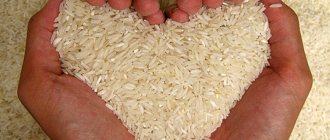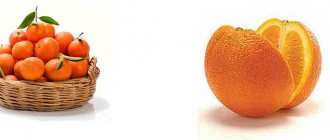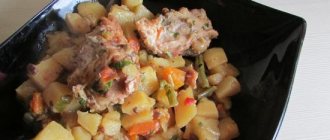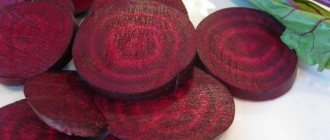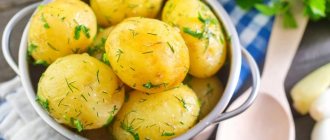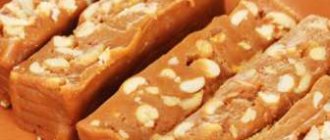Calorie content
The advantage of this crop is its low calorie content. It directly depends on the variety
. It happens:
- Round-grained;
- Long grain;
- Medium grain;
- Brown;
- Black.
The calorie content of this dietary product in its raw form is on average 285-380 Kcal and has the following energy value indicators:
- Kcal per 100 g – 260;
- Squirrels, gr. - 8;
- Fats, gr. – 2.5;
- Carbohydrates, gr. – 60.
After cooking, the calorie content decreases further and amounts to 100-150 cal per 100 g. Thanks to such a low calorie content, it is perfect for dietary nutrition, as well as for fasting days and diets.
Calories in fried rice
increases significantly and depends on the frying oil used. The minimum will be one hundred and fifty kcal per 100 grams of product.
Also, calorie content depends on the volume of water that is absorbed into the cereal during cooking. So, when preparing 100 grams of long-grain rice (calorie content 370 kcal), you can add 300 ml, and the result will be 300 grams of a finished dish with a calorie content of 370 kcal per 100 grams. If the liquid evaporates during cooking, the calorie content will be correspondingly lower.
If fruits, honey, sugar, butter, milk or vegetables are added to the finished dish, then it will be more nutritious.
This product is very useful for the body not only as a dietary supplement, but also as a source of vitamins and minerals. It contains phosphorus, potassium, as well as vitamins B, E, PP, H, iron, magnesium, silicon, manganese, zinc, sulfur, calcium, sodium. All these substances are very necessary for the human body and have a beneficial effect on the functioning of all organs.
This product contains amino acids, which are indispensable for increased physical activity on muscles, as well as for diseases of the gastrointestinal tract. It contains a large amount of dietary fiber
and starch, which have a beneficial effect on the functioning of the intestines and the entire digestive system.
Rice product with various additives
If you add other ingredients to the rice, it will be a finished dish, and not just a side dish. By improvising with ingredients, you can get delicious dishes of Russian, Italian, Japanese cuisine, as well as vegetarian and dietary ones.
Video
Rice cooked with additives has a different calorie content than components that were cooked separately from each other. The caloric content includes oil and other ingredients that go into the dish. The table shows the calorie content of the components that are usually added to rice.
| Additive | Kcal per 100 g | Rice + additive per 100 g |
| Oil | 749 | 126 |
| Onion | 44 | 125 |
| Carrot | 38 | 102 |
| Vegetables | 41 | 114 |
| Beef | 198 | 206 |
| Pork | 293 | 138 |
| Chicken | 167 | 132 |
| Ground meat | 285 | 233 |
| Seafood | 113 | 123 |
| Egg | 144 | 95 |
| Cabbage | 29 | 88 |
| Raisin | 268 | 169 |
Oil has a huge calorie content, but only up to 5% of it can be added to rice, unlike other dishes, which are flavored with at least 20% of it, so the finished dish has a low calorie content. The calorie content of a dish with additives increases depending on the cooking method. Boiled it will be much lower than fried.
Video
For weight loss
This is an excellent absorbent that helps remove toxins from the body. It is also a source of complex carbohydrates, which saturates the body with energy for a long time.
This is a very satisfying product, but at the same time quite low in calories. Most therapeutic diets and weight loss diets are based on this product.
Rice-based diets are:
- Gentle - replacing a portion of rice with other high-calorie foods
- Hard – eating only boiled rice cereal and nothing else. Freshly squeezed juices are allowed.
It is not recommended to eat only rice, since this crop does not contain all the necessary vitamins and microelements that a person needs for the normal functioning of all internal organs. It is best to spend fasting
days
using this product, which is boiled without salt and without adding oil.
As a diet for weight loss, you can eat it along with a piece of boiled lean meat, chicken or turkey fillet. You can also add fruit and honey, as well as nuts.
Nutrition during a diet should be balanced and include proteins, fats and carbohydrates. It is important to reduce the calorie content of your meals. Rice cereal will help with this perfectly.
There are diets in which the cereal is not boiled, but is soaked in cold water. The soaked cereal should be left in water for four days, but the water should be changed every day.
Comparison with other products
Throughout the country, rice, potatoes and buckwheat are considered favorite side dishes. They are all healthy and tasty, they cook in approximately the same time, but they differ in calorie content.
| Product | Kcal |
| Boiled | |
| Rice | 117 |
| Buckwheat | 113 |
| Potato | 84 |
| Fried | |
| Rice | 189 |
| Buckwheat | 109 |
| Potato | 189 |
| Stewed | |
| Rice | 159 |
| Buckwheat | 131 |
| Potato | 104 |
Rice is considered the most nutritious, buckwheat has low calorie content and is good for weight loss, and potato dishes occupy a neutral position.
Video
How to choose the right product
You need to focus on the dish that you plan to prepare from rice, since different types are suitable for different dishes. So, for example, round grain is perfect for making milk porridges and sushi. Long grain steamed will crumble well
in pilaf. Black is the healthiest type and is well suited for salads. Medium grain rice makes a wonderful risotto.
When purchasing you must:
- check the date of manufacture and shelf life;
- choose a well-known, trusted company;
- make sure that the cereal in the package is clean (there are no foreign objects or additives);
- check the integrity of the grain and its color.
If there are a lot of crushed grains in the pack, then this product is of poor quality. A yellow tint to the rice or a coating on the grains also indicates a bad product. Good quality rice, matte in appearance, the same size without any foreign additives in the pack.
How much should you eat every day
An adult can eat up to 500 grams per day. In Asian countries, this figure can be much higher, since this crop is the main dish in the diet of residents. Children can eat no more than 200 grams.
With diets and proper nutrition
this wonderful product should form the basis of an adult’s diet. Its use should be regular.
You can prepare a wide variety of dishes from it, both simple and more complex.
Vegetable soups, rice and cottage cheese casseroles, salads with lean meat and parsley, with vegetables, rice with meat, risotto, pilaf, milk porridge - this is not the entire list of dishes that can be prepared from this wonderful product.
Rice is suitable for those who adhere to proper nutrition, are on a therapeutic diet or are losing weight.
Jan-14-2013
Dietary properties of boiled rice:
Rice is a surprisingly popular food item in almost every corner of the globe. Residents of the countries of the former USSR associate rice mainly with oriental cuisine. It is believed that one of the reasons for the slimness of the Japanese and Chinese is boiled rice, which is an integral part of their national cuisine.
And really, how many calories are in boiled rice? Is it as useful as we used to think? And if useful, then in what way?
Before we talk about how many calories are in boiled rice, let's first remember what its benefits are for us. It should be noted that the attractiveness of rice is due not only to its relatively low calorie content, but also to its excellent taste and nutritional value. Rice is a very nutritious food product, which is noticeable at least by the amount of healthy carbohydrates contained in boiled rice.
Carbohydrates serve as “fuel” for the human body, which is converted into the energy it needs. Although, brown rice can give us more useful energy.
Unfortunately, by removing the husk from rice grains, we also deprive the product of a large amount of vitamins and other useful components. But even refined rice is still a rich source of calcium, phosphorus, potassium, and B vitamins.
Specifics of processing and differences in appearance of cereals
The size and shape of the grain does not depend on further technological influence, but on the variety of rice. It can be long or short, oblong or round. Parboiled rice can be easily distinguished externally only by color. Regular polished grains have a white, even snow-white hue, while steamed grains have a golden-amber hue. True, after cooking, steamed rice turns white and becomes little distinguishable from its refined counterpart.
The largest amount of vitamins and other valuable substances is contained in the shell of rice grains. Grinding, which is applied to raw rice after cleaning, removes it completely, depleting the nutritional composition. This procedure extends the shelf life, makes the grain even, smooth, translucent, and improves its presentation. However, steamed but polished rice is not completely deprived of valuable nutrients.
The main difference between parboiled rice and regular rice is hydrothermal treatment. The sifted grain is first placed in hot water for a while and then steamed. Under the influence of steam and pressure, more than 75% of the necessary microelements (mostly water-soluble) are transferred to the inner shell of the grain (endosperm), and the starch is partially destructured. That is, further drying and grinding equipment will not have a significant negative effect on the grain.
What types of rice are there?
Arborio
Perhaps our most famous is Italian medium grain rice. Used to prepare risotto and puddings. Having absorbed a lot of water, arborio does not turn into a messy porridge, but gives the dish a creamy consistency.
Vialone nano
This variety of medium-grain Italian rice for first courses absorbs more liquid than Arborio, and its risotto turns out less creamy, a little dry - for lovers of rice with a hard core.
Carnaroli
Medium-grain Italian rice for risotto Compared to arborio and vialone, carnaroli contains more starch, and the risotto turns out “creamy”. Never wash rice for risotto - you will wash away the most important thing - starch.
Italica
We sell classic medium grain rice under this name. The ratio of the length of the grain to its width is less than 3:1. It is used to make pilafs of various kinds, soups and hot dishes with meat, fish and seafood.
Basmati
This is a long grain indica rice.” The ratio of length to width is 3(4):1. The best basmati is grown in the foothills of the Himalayas in northern India and Pakistan. When cooked, the grains elongate greatly and do not break.
Jasmine
The main producers of this long grain rice are Thailand, Cambodia and Vietnam. Translucent grains become soft when cooked and break easily. Fragrant jasmine is steamed and served with all Thai dishes.
Brown (brown)
This is unpolished rice, in which the outer shell with all the vitamins (especially group B) remains intact. It is very healthy, but requires more time to prepare and does not last long.
Red
Unpolished rice, healthy. The red shell can be of different shades - from light to purple, it takes longer to cook than polished, and has a strong, persistent, pleasant aroma. Can be used in soups, salads and pilafs.
Camargue
This semi-wild red rice with an incredible aroma and nutty taste comes from the south of France. It can be cooked as a paste in plenty of salted water and served with olive oil with vegetables or meat.
Devzira
Central Asian medium grain rice with a pinkish-brick hue. It is from this that the most delicious pilafs in Central Asia are cooked. It requires thorough washing, after which it loses some of its color, but does not become white.
Japan
We sell short grain rice under this name, which characterizes an entire category. When cooked it becomes soft and sticky. It is used for making soups and desserts, but its main “purpose” is sushi and rolls.
Culrose
This short grain rice was developed in California in the early 1970s. When cooked, it becomes fragrant and soft, and the grains stick together well - making calrose an ideal sushi rice.
Round-eyed Krasnodar
This rice has a length to width ratio of less than 2:1. It can absorb a lot of liquid when cooked, becoming soft and creamy. Used in porridges, soups, pie fillings and desserts.
Asian sticky
It is also sweet rice, waxy, pearl or mochi. This is short grain rice that becomes sticky after cooking. It is steamed and desserts are made from it. And in Laos and Northern Thailand, this is the only rice they eat.
Black Thai
It is glutinous unpolished rice and is white inside. Thanks to the dense outer shell, Thai black rice does not become soggy when cooked. This gives its taste a special sophistication. Thais prepare desserts from this rice.
Wild rice
This is not rice at all, but the seeds of an aquatic grass, very similar in shape to rice. Thin black grains reach a length of 3 cm. When boiled, they almost do not increase. Wild rice is harvested by hand and is therefore expensive.
Recipe? Recipe!
How to cook rice correctly? Here is one of the recipes:
Boiled rice:
Products:
- Rice groats
For cooking we need rice and water in a ratio of 1:2. The rice is pre-washed, placed in a pan and filled with water. If you want to salt the rice, you should do it right away. Put the pan on the fire. When it boils, turn the heat to low and cook the rice for 25-29 minutes. The final result will be largely determined by the quality of the cereal. To get fluffy rice, you can choose more expensive grains and not stir it during cooking.
You can enjoy the result by adding a little butter to the dish. In this case, the nutritional value of rice will be minimal.
Rice is the oldest grain on our planet. The most interesting thing is that it is very unpretentious and grows in almost any climate on different soils. Therefore, there are many places on the planet where rice farming is thriving.
This ancient crop ranks second in the world in terms of crop area, and in first place in terms of gross product collection.
Therefore, there is a lot of attention to rice and scientists from all over the world are trying to preserve this culture.
Rice is very popular and accessible. This is primarily due to the fact that it has excellent nutritional value and goes very well with other foods: sour, spicy, salty and sweet.
Calorie content of boiled rice
The calorie content of boiled rice porridge is on average 116 kilocalories per 100 grams.
It contains a large amount of carbohydrates - 24.9 g. Contains calcium, B vitamins, as well as potassium and phosphorus. Rice has virtually no fat and no protein.
If you take some dry rice per 100 grams of product, it will be 360 kilocalories.
However, during the cooking process, rice absorbs water and therefore the final calorie content is reduced by 3 times. Thanks to this property, rice can be included in a special group of low-calorie foods.
There are many diets that are based on rice. In this case, both the most stringent rice diets can be used, for example, you can boil several servings of rice and simply wash them down with apple juice throughout the day, as well as more gentle ones, in which rice is simply added to other foods.
In general, rice diets last a maximum of two weeks. In any case, nutritionists recommend consuming boiled rice in its unrefined form, since it will contain sufficient amounts of all B vitamins.
If you decide to go on a rice diet, be sure to stock up on vitamins that contain potassium.
The low calorie content of boiled rice is used for all kinds of fasting days. For example, you can take 200 grams of rice, boil it in water and eat it throughout the day.
Rice is a very ancient product and was first used more than four thousand years ago in Asia. Many peoples of the world consider rice to be a gift from God, as well as a symbol of fertility, and try to protect this culture.
Rice has many beneficial properties. For example, it contains a very high amount of carbohydrates and lacks gluten, which can cause various allergic reactions. 8%
rice contains protein and vitamins B3, PP, as well as B 1 and B 2 and B 6. They allow you to convert all nutrients into useful energy.
In addition, due to this transformation, the nervous system is strengthened, the skin becomes healthier, and the condition of nails and hair improves. Thanks to lecithin, brain activity is accelerated. The oligosaccharide content restores the intestines.
The composition of rice helps a person cleanse himself of toxins and waste.
Rice is recognized as the best means for such cleaning. There is an interesting method: you need to take as many spoons of rice as you have lived for years, then pour boiled cool water over it, and then put the resulting mixture in the refrigerator. After this, you need to eat one spoonful of this rice every morning.
In this case, every day it is necessary to change the water in which the rice is located. It is recommended to use this supplement before seven o'clock in the morning or two hours before meals. This must be done until all the rice has been eaten.
Today, more than 23 varieties of rice are known. Rice can be either white or brown, black or red, or lilac. Rice cereals can not only be of different colors, but also differ in taste, as well as in the method and time of preparation. In addition, their nutritional value also differs.
Many pharmaceutical companies have already appreciated the beneficial properties in cosmetics. On the shelves you can find many products that are based on rice.
Calorie content of rice with raisins per 100 grams
Calorie content of rice with raisins per 100 grams is 174 kcal. In 100 g of dish there are 2.1 g of protein, 5.9 g of fat, 28.6 g of carbohydrates.
- Rice and raisins are thoroughly washed;
- the rice is boiled until half cooked under the lid over medium heat for 8 - 10 minutes;
- Add 50 g of raisins, half a tablespoon of sugar, salt (to taste), 50 g of butter to the pan with rice. All of these components are mixed and cooked for 15 minutes until the rice is completely cooked.
Rice - benefits and harm
Rice actually contains many useful elements and scientists have already proven that thanks to this useful product the functioning of the nervous system is improved, and the condition of the skin and hair is maintained in excellent healthy condition. In addition, rice is used to restore lost appetite. If there is a high temperature, then a decoction of rice will be an excellent help in this case.
It is difficult today to find products other than bread and potatoes that would be as popular as rice, which is present in many, including the most popular, dishes. In some eastern countries it replaces bread, and it is the constant consumption of rice that is associated with the fact that there are fewer overweight people in Asian countries. Rice groats are obtained by grinding, after which it acquires an oblong or round shape. Its calorie content depends on the shape of rice and its variety. Most often we use white rice, but it also comes in brown color, and such rice differs significantly in its composition and calorie content. Knowing how many calories are in rice, many people use it for weight loss, and rice is part of many diets.
Benefits of white rice
The following benefits of white rice are known:
- due to the large amount of fiber in the product, porridge is useful for the prevention of stomach and intestinal cancer;
- rice stimulates brain function and inhibits the aging process;
- rice water has pronounced strengthening properties, therefore it is widely used for diarrhea;
- rice stimulates the functions of the nervous system, which makes this product an essential element of the diet for the prevention of senile dementia;
- With regular consumption of porridge, cholesterol levels in the blood decrease;
- Rice contains a minimal amount of sodium, so it is indicated for problems with blood flow and a tendency to edema.
Composition and beneficial properties of rice
In addition to the fact that rice dishes add uniqueness to any dish, it is also a very healthy product that contains a large amount of useful substances. Particularly noteworthy are the B vitamins, which are involved in normalizing the body’s activity and improving its protective functions; in addition, rice contains a sufficient amount of nicotinic acid or vitamin PP, which can reduce cholesterol levels. Vitamins E and H are also present in rice.
Those who are interested, first of all, in how many calories are in boiled rice should know that rice cereal is rich in minerals, among which potassium deserves special attention, which normalizes the functioning of the heart muscle and is able to remove excess water from the body. Rice is also a storehouse of chemical elements such as phosphorus, magnesium and iron, but it is especially rich in silicon. There are also other minerals, the presence of which has a beneficial effect on the functioning of the body.
Rice is recommended for consumption not only by those who are concerned about their figure, but also by people with health problems. Considering the fact that rice contains practically no sodium, but enough calcium, the latter easily neutralizes sodium salts, and this property will be appreciated by people with kidney problems and those who suffer from cardiovascular diseases. Rice, among other things, contains lecithin, which improves memory, making it useful for older people. Rice broth contains a substance that can coat the walls of the digestive tract, and this is useful for people suffering from gastritis and ulcers.
Calorie content of rice
People who are prone to obesity are interested in how many calories are in boiled rice, but this question cannot be answered definitely. This depends on many factors, but it is known for sure that when cooking, the calorie content is reduced by three times. 100 grams of dry rice contains 280-370 kcal, and the energy value of boiled rice is already 80-140 kcal per 100 grams of product, which makes it indispensable in dietary nutrition, especially considering that it is filling and contains a huge amount of carbohydrates that accumulate in muscle tissue.
The calorie content of foods depends on what we consume them with. Therefore, when asking the question how many calories are in rice porridge, you should clarify what you will eat it with. Rice is a good side dish for various dishes, and to understand, for example, how many calories are in rice with meat, you need to know the calorie content of the meat itself, and it differs depending on the type and type of meat. In schools and preschool institutions, they care about the health of children, so catering workers are required to know how many calories are in rice porridge with milk - a favorite dish of many children. Such porridge “weighs” about 100 kcal, and knowing how many calories are in rice porridge with water, which is 80 kcal per 100 grams, you can safely include such porridge in your diet.
Rice can be cooked not only with meat and milk, it goes well with vegetables, therefore, having learned how many calories are in rice boiled in water, you can calculate how many calories are in rice with vegetables. A dish that includes a standard set of vegetables, including carrots, bell peppers, onions and garlic, contains approximately 100 kcal, and this is already taking into account the vegetable oil in which the vegetables were fried. Without oil, the “weight” of the dish is reduced, and it can also be considered dietary.
Nov-12-2012
Calorie content of stewed cabbage with rice per 100 grams
Calorie content of stewed cabbage with rice per 100 grams is 106.4 kcal. A 100-gram serving of the dish contains:
- 2.23 g protein;
- 5.27 g fat;
- 13 g carbohydrates.
- 1 onion and 1 carrot are finely grated and fried in vegetable oil;
- 0.5 kg of cabbage is chopped and added to fried vegetables;
- cabbage with onions and carrots is mixed with a small amount of vegetable oil and stewed until half-cooked;
- make a hole in the middle of the stewed cabbage, add 4 tablespoons of washed rice and a little salt (to taste);
- the dish is simmered under a closed lid until the rice is cooked;
- Before serving, all components of the dish are thoroughly mixed.
A little about rice:
Rice porridge has been familiar to everyone since childhood, and rice, as an agricultural crop and food product, is not only popular, but also a staple in many countries. This product is very popular here too. Therefore, the question of how rice is useful, the calorie content of boiled rice, is far from idle. Especially for women.
Rice as a crop is one of the oldest cereals. Archaeologists and historians claim that this culture was known in the East already in the third millennium BC. Rice appeared in Europe about two or three hundred years ago.
Many, of course, know, but it doesn’t hurt to remind you that this cereal is classified according to the shape of the grain. According to this classification, rice can be short-grained, medium-grained, or long-grained. Depending on how it is processed, there are white, parboiled and brown rice.
Rice (milled, polished and crushed) has the highest starch content - up to 75%. Rice cereal is easily digestible and contains almost no fiber. There are relatively few proteins, but in terms of amino acid composition they are more complete than the proteins of other types of cereals. There are few minerals and vitamins in rice cereals.
Rice is widely used in dietary nutrition when it is necessary to spare the digestive organs, as well as in cases of exhaustion. Rice is an excellent food for older people, but is not recommended for those who are prone to obesity.
The cooking time for rice cereal is about an hour, and the volume increases five to six times.
Nutritionists say that rice as a basis for nutrition is ideal because it is rich in a variety of beneficial substances and does not contribute to obesity. In 150 gr. There is no more fat in rice than in a third of a slice of white bread, but in protein - as in half a glass of milk, calcium - as in one tomato, magnesium - as in five stalks of asparagus. Rice also contains vitamins B and E, iron and plant fiber. Rice is divided into long grain, short grain and medium grain.
The aroma and color depend on the place of cultivation and the method of processing after harvesting. The basmati variety is grown in India at the foot of the Himalayas and has a delicate aroma. The jasmine variety grows in Thailand - it is a white long-grain aromatic rice. Brown rice has a shell containing many vitamins and minerals, which gives the grain its brown color. The Aquatica variety acquires a dark color after drying in the sun.
Features of the rice diet
The calorie content of boiled rice is not too high, so it is readily included in all kinds of diets. But nutritionists do not advise losing weight on rice alone, as the body may not receive enough of some useful elements. Therefore, you need to add other ingredients to the rice.
Standard Rice Diet
The rice diet can be hard or soft. Hard - pour boiling water over a glass of rice and let it swell. Then divide it into 5 servings and eat it a day without any additives. Soft means eating rice dishes with additives three times a day.
An approximate daily diet is as follows:
- Breakfast can be like this: porridge in water with fruit: pieces of apples, oranges or grapefruits.
- For lunch, make rice boiled in salted water with stewed mushrooms, carrots or boiled broccoli.
- For dinner, cook rice with steamed vegetables, cucumber salad with yogurt.
The diets are strict, so you can stay on them for no more than 5 days, and you need to drink at least 2 liters of water.
Video
Rice-buckwheat
Cereals go well together, as they contain useful elements that complement each other. This diet is much easier to maintain than a pure rice diet. It is as effective as a mono-diet. The mixed diet should last no longer than 5 days.
The daily menu is developed according to the same principle:
- breakfast - any fruit;
- lunch - rice porridge with a mixture of nuts;
- snack - fresh vegetable salad;
- dinner - boiled buckwheat with boiled chicken breast or steamed fish.
If you feel hungry, you are allowed to eat a portion of low-fat cottage cheese without additives.
Video
Rice-honey
This is a strict mono-diet, you should not stick to it for more than 5-7 days. It is not so dangerous compared to some single-ingredient diets, because honey supplies the body with many useful elements. This diet is contraindicated for people who are allergic to honey and other bee products.
Please note: There are two components involved in dietary nutrition: rice and honey. Consumption is simple. Half a kilo of rice porridge is divided into 5 meals and eaten throughout the day. Additionally, prepare a glass of honey drink with the addition of lemon and drink it 3 times during the day. During the diet, other than drinking water, other foods cannot be introduced into the diet.
Dietary properties of rice:
The low calorie content of rice, including the calorie content of boiled rice, as well as its other beneficial properties, are explained by its unique composition. It contains 7 to 8 percent protein, which in turn contains eight essential amino acids. These amino acids are essential in the creation of new body cells. Rice can be safely given to allergy sufferers, as it does not contain gluten. In addition to proteins, rice contains B vitamins: vitamin B1 - 0.08 mg, vitamin B2 - 0.04 mg, vitamin B3 - 0.45 mg, vitamin B6 - 0.2 mg, vitamin B9 - 1.9 mg, vitamin E – 0.4 mg, vitamin H – 3.5 mg, PP – 1.6 mg.
This cereal is not deprived of minerals and has up to 100 mg of potassium, 8 mg of calcium, 50 mg of magnesium, 12 mg of sodium, 1 mg of iron, 46 mg of sulfur, 150 mg of phosphorus, 25 mg of chlorine, 100 mg of silicon, etc. It contains and trace elements - zinc, boron, manganese, copper, nickel, molybdenum, fluorine, cobalt, chromium.
Rice is rich in complex hydrocarbons, which can maintain a long-term flow of energy for the human body, and lecithin, which rice contains, is useful for people engaged in intellectual activity.
This cereal also contains substances that coat the stomach, so rice is useful for people suffering from stomach ulcers and gastritis. Rice water is recommended for use for various stomach disorders.
Rice is very useful for people with cardiovascular diseases, with diseased kidneys, blood vessels and joints, since it contains practically no salt and is rich in sodium and potassium. And the lack of fiber can be compensated by adding vegetables to rice dishes.
So, what is the calorie content of rice? Like this, depending on the type:
Calorie table for rice, per 100 grams of product:
And the nutritional value of rice cooked in different ways is as follows:
Table of nutritional value of rice (BZHU), per 100 grams of product:
| Rice | Squirrels, gr. | Fats, gr. | Carbohydrates, gr. |
| white | 6,7 | 0,7 | 78,9 |
| brown | 6,3 | 4,4 | 65,1 |
| wild | 10,0 | 0,66 | 54,0 |
| Mistral Aquatica Color Mix | 8,8 | 2,3 | 72,8 |
| Mistral Aquatica Wild | 14,0 | 0,5 | 72,0 |
| Mistral round grain | 0,1 | 0,4 | 79,5 |
| Mistral steamed | 7,1 | 0,7 | 79,3 |
| polished | 7,0 | 1,0 | 71,4 |
| unpolished boiled | 2,7 | 0,7 | 36,0 |
| white boiled | 2,2 | 0,5 | 24,9 |
| wild boiled | 4,0 | 0,3 | 21,1 |
| brown boiled | 2,6 | 0,9 | 22,8 |
At first glance, the calorie content of dry rice is not very small. What explains the low calorie content of boiled rice? The fact is that during the cooking process, dry rice increases its volume almost three times. Therefore, if we cook one hundred grams of dry rice, then as a result we will have three hundred grams of boiled rice. But since water has no calories, the calorie content of boiled rice does not change in any way compared to dry rice. So if we cooked one hundred grams of white rice, we will get three hundred grams of porridge, which will contain 340 kcal. Hence:
The calorie content of boiled rice will be 113 kcal per hundred grams of product
How to cook rice correctly? Here's a simple recipe for you:
Products:
- One glass of rice
- Two glasses of water
- A pinch of salt
Take two glasses of water for one glass of rice. Pour water into a saucepan and bring to a boil. Add salt, add rice to the salted water, stir, reduce the heat on the stove to low and close the lid tightly. Cook for exactly 25 minutes, with the lid closed. That's all! And the dish is tasty and the low calorie content of rice will not add extra pounds to you.
Calorie content of rice: white, brown, wild, red, basmati - Pohudeikina
Rice is a favorite product of Japanese centenarians and a healthy dietary food.
Find out the calorie content of different types of rice, as well as ready-made meals, and include them in your menu without risking your waistline. Rice is loved and appreciated all over the world. This grain is very nutritious and goes well with spicy, sour, sweet and salty foods.
Therefore, both simple and exotic dishes are prepared from different varieties of rice: side dishes, soups, salads, desserts, etc. In addition, diets and fasting days on rice are popular.
But, like any product, it contains calories, the consumption of which should be controlled to maintain slimness.
- It contains about 80% complex carbohydrates, so it should be included in the diet of those who want to lose weight. Carbohydrates tend to accumulate in muscles and provide a long-term flow of energy into muscle tissue.
- It contains almost no salt, so it is recommended for use by people with kidney diseases and disorders of the cardiovascular system.
- Potassium contained in rice neutralizes the aggressive effects of salt, which enters the body with other foods and removes its excess. This helps remove excess fluid from the body and improve metabolism.
- Does not contain gluten, a vegetable protein that can cause a severe allergic reaction.
- It is a source of B vitamins (B1, B2, B3, B5, B6, B9), which stimulate the functioning of the nervous, cardiovascular, digestive and endocrine systems, and vitamins E, PP, H.
- Has enveloping properties. Once in the digestive system, rice gluten gently envelops the walls of the stomach and esophagus. Therefore, the product is useful for people suffering from ulcers, gastritis and high acidity.
Macro- and microelements contained in rice (per 100 g)
- Calcium (40 mg).
- Magnesium (116 mg).
- Sodium (30 mg).
- Potassium (314 mg).
- Phosphorus (328 mg).
- Chlorine (133 mg).
- Sulfur (60 mg).
- Iron (2.1 mg).
- Zinc (1.8 mg).
- Iodine (2.3 mcg).
- Copper (560 mcg).
- Manganese (3.63 mg).
- Selenium (20 mcg).
- Chromium (2.8 mcg).
- Fluoride (80 mcg).
- Molybdenum (26.7 mcg).
- Boron (224 mcg).
- Vanadium (400 mcg).
- Silicon (1240 mg).
- Cobalt (6.9 mcg).
- Aluminum (912 mcg).
- Nickel (51.6 mcg).
100 g of rice contains 6.7 g of protein, 1.5 g of fat, 78 g of carbohydrates, 9.7 g of dietary fiber and 30 g of sodium. The calorie content of rice depends on its variety.
White. The grains undergo all stages of grinding, so they lose some of their beneficial properties (unlike unpolished grains). It is quick to prepare and most common in cooking. White rice contains 344 kcal.
Unsanded brown (brown). It is considered the most useful variety, since it is peeled only from the outer husk, preserving all the bran and nutrients. Unpolished rice removes cholesterol, stabilizes blood circulation, improves kidney function and normalizes water balance in the body. The calorie content of brown rice is 337 kcal.
Wild. It contains an almost complete list of proteins necessary for the human body (about 15 g of proteins per 100 g). Regular consumption of wild rice strengthens the muscular system, improves metabolic processes, and stimulates the functioning of the immune and digestive systems. Calorie content - 101 kcal.
Red. It has a low glycemic index (55), which allows it to be consumed by people suffering from diabetes.
Red rice contains fiber, which improves digestion, adsorbs fats, lowers cholesterol levels in the blood and stimulates intestinal motility. In addition, it contains anthocyanins, which are powerful antioxidants.
They slow down the aging process and prevent the occurrence of cancerous tumors. Calorie content of red rice is 362 kcal.
Long grain. Long-grained are those varieties of cereals whose grains reach 6 mm or more in length. Due to its high fiber content, it is very beneficial for the gastrointestinal tract. The calorie content of long grain rice is 365 kcal.
Basmati. Contains fiber and amylase, which improves the functioning of the pancreas. The energy value of basmati rice is 342 kcal.
Steamed. Steaming is a technology that allows you to improve the quality characteristics of rice cereals. When steamed, vitamins and minerals from the shells are transferred to the grains, and starch is destroyed, which is why this rice becomes more crumbly. Calorie content of steamed rice is 341 kcal.
Air. Calorie content of puffed rice is 402 kcal. This is a good option for a hearty and healthy breakfast. Since puffed rice contains high amounts of fiber and protein, such a breakfast will provide a long-lasting feeling of fullness.
For sushi. You can prepare it yourself from round grain (for this you will need rice vinegar and nori seaweed), or buy ready-made. The calorie content of rice for sushi is 330-350 kcal.
The calorie content of 100 g of raw and 100 g of cooked rice differs significantly due to the fact that during cooking the grains absorb water. Accordingly, the mass increases.
Thus, 100 g of boiled white rice without additives contains only 116 calories, 100 g of boiled brown rice has a calorie content of 110 calories, 100 g of boiled unpolished rice contains 125 calories, and 100 g of boiled wild rice contains only 78 calories. As a rule, salt, butter, raisins are added to rice or boiled in milk.
To calculate the calorie content of supplements, consider the amount of ingredients. If this concerns milk, pay attention to its fat content. Salt will not add calories, since its energy value is zero.
But a large amount of salt can provoke fluid retention in the body and, as a result, stress on the kidneys and swelling. 100 g of butter contains 748 calories. By adding only 3 g of butter to a dish, you will increase its calorie content by 23 calories.
If you like rice with raisins, remember: the calorie content of 100 g of raisins is 264 calories. 15 g of raisins will increase the calorie content of your dish by 40 calories, and 1 teaspoon of sugar - by 16. If you cook rice porridge in milk (2.5% fat) without additives, its calorie content will be 110 calories per 100 g.
The energy value of steamed is slightly higher than boiled. 100g of steamed white rice contains 151 calories.
The energy value of rice with vegetables depends on the cooking method and ingredients. For example, the calorie content of boiled rice with stewed vegetables (sweet peppers, carrots, green peas and corn) + 2 g of vegetable oil is about 118 calories.
Depending on the particular seafood, type of rice and additives, the calorie content of fried brown rice with seafood (mussels) + 3 g of vegetable oil is 124 calories.
Meatballs. If you are watching your figure, choose minced chicken for making meatballs. The calorie content of meatballs with rice in tomato sauce is about 154 kcal.
Pumpkin porridge with rice. Pumpkin porridge is prepared with water or milk. If you cook it with milk, pay attention to its fat content. Thus, the calorie content of pumpkin porridge with milk (3.2% fat) with sugar is 120 kcal.
Chicken soup with rice. The energy value of this hot dish is only 90 kcal per 100 g.
Crab salad with rice. The calorie content of crab salad with rice increases if you add fatty mayonnaise to it (150-170 kcal per 100 g). If you want to make the salad less high in calories, season it with low-fat sour cream (10-15% fat content - 23-31 kcal per 20 g). The calorie content of the salad will be 135–150 kcal.
Stuffed cabbage rolls with meat. The calorie content of cabbage rolls with minced pork and beef and rice is 230 kcal.
The rice diet is a huge success all over the world. Rice effectively cleanses the body of waste and toxins, removes excess fluid and improves skin condition. At the same time, it is nutritious, which leaves virtually no chance for obsessive hunger.
There are several options for the rice diet.
"2 courses"
For five days you need to eat according to the following principle:
- Breakfast: 200 g boiled rice + 1 cucumber.
- Second breakfast: 200 g of boiled mussels + 50 g of green peas.
- Lunch: 200 g boiled rice + 1 tomato.
- Afternoon snack: 150 g baked pollock + 1 sweet pepper.
- Dinner: 170 g boiled rice + 1 cucumber.
Drink at least 2 liters of clean, still water every day.
Seven day diet
For seven days you should eat only boiled rice (without salt and oil) with fresh vegetables and herbs. The amount of vegetables should be less than the amount of rice. You should drink at least 2 liters of still water. It is recommended to drink green or mint tea (without sugar).
- Breakfast: 250 g of boiled rice, 1 cucumber, 1 tomato.
- Second breakfast: 2 cucumbers, green tea.
- Lunch: 200 g of boiled rice, 100 g of salad (cucumbers, tomatoes, bell peppers, carrots, green peas + 2 teaspoons of olive oil).
- Afternoon snack: 100 g boiled rice, 1 tomato.
- Dinner: 200 g steamed rice, green tea.
Express diet “A glass of rice”
This is an effective three-day fasting option for the body. The diet should not be repeated more than once every 15 days.
The bottom line: 200 g of rice should be boiled (or steamed), divided into portions and eaten throughout the day. If you feel very hungry, eat 1-2 apples. Every hour, try to drink 150–200 ml of clean water at room temperature. It is allowed to drink green tea with lemon (without sugar).
Exit from the diet: over the next three days, consumption of rice soup with chicken broth, fresh and stewed vegetables and fruits, and boiled (baked) meat is allowed.
Questions for a nutritionist on this topic
Source: https://pohudejkina.ru/kalorijnost-risa.html
